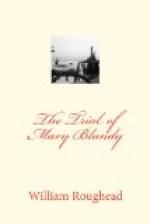(From the original MS. in the possession of Mr. John A. Fairley.)
Edinburgh, April 16th, 1843. 57 Melville Street,
My Dear Sir,—I herewith return
your Blandy and Cranstoun
collections, with many thanks.
I certainly understood from the late James Rutherford, Esqr., of the Customs, Edinburgh, a cadet of the Rutherfords of Edgerston, and through his mother, a female descendant—one of the nearest—of the Edmonstones of Corehouse, that it was in consequence of the great exertions of an Edmonstone of Corehouse that the guilty Cranston was first concealed, and afterwards enabled to escape abroad. I think he said that the Edmonstones of Corehouse were descended, or relatives, of the Cranstons, but that the latter were not descended of the former, or could be in any respect their heirs.
A greater intimacy, however, subsequently arose between the two families, owing to the friendly exertions of the Edmonstone as above, that ended in a superannuated lady, the late Miss Edmonstone of Corehouse, entailing or settling her estate upon the present George Cranstoun of Corehouse,[34] nephew of the poisoner, to the exclusion of the late Roger Ayton, and her other heirs at law. In this manner the Cranston family may be said to have benefitted by his atrocity, and advantage to have resulted from evil; the friendship or kindness of the Edmonstones having been rivetted and increased towards the relatives of him they had rescued, and whom, on that account, they additionally cherished—this I learnt from the previous authority referred to. Nay, the old lady wished above all things that the ci-devant judge should marry and continue his line, a thing that for some special reason he did not desire, and found it difficult to stave off to her. This also from the same authority. Though very old, no legal ground could be found on enquiry by which her settlement could be voided.
The following excerpt from the Statement of the Evidence submitted to the jury, on the occasion of the present Admiral Sir Thomas Livingstone of Westquarter, Baronet, being served heir-male of James, first Earl of Calender in 1821, in which I was professionally engaged, shews what became of the issue of William Henry Cranstoun, the poisoner. Alexander (Livingstone) of Bedlormie and Ogilface, afterwards Sir Alexander Livingstone, Bart., having succeeded to the Scottish Baronetage of Westquarter and to the estates of that branch of the house of Livingstone, was twice married; first to Anne Atkinson, daughter of John Atkinson of London, and secondly to Jane Cranston, daughter of the Honourable William Henry Cranston, fifth son of the Lord Cranston. By his first marriage he had seven sons, Alexander, William, Thomas, the claimant (still alive), John, Thurstanus, James and George, and one daughter, Anne, married to the Rev. John Fenton of Torpenhow, in the County of Cumberland. By his second marriage he had two sons, Francis and David, both dead unmarried, and one daughter, Elizabeth, married to James Kirsopp, Esquire, of the Spital, Northumberland.
I remain,




